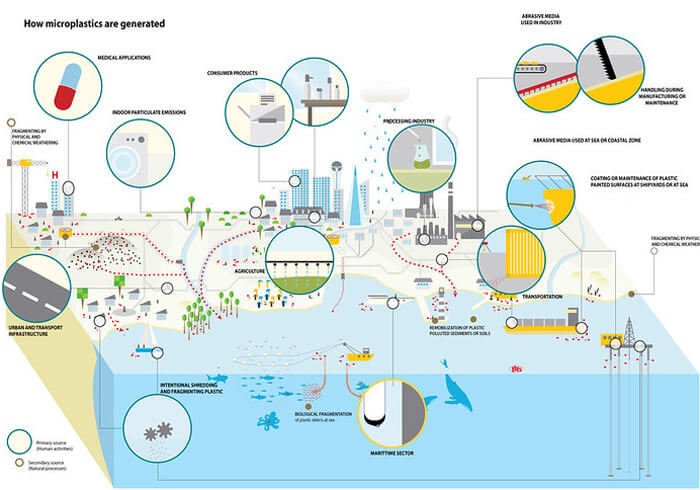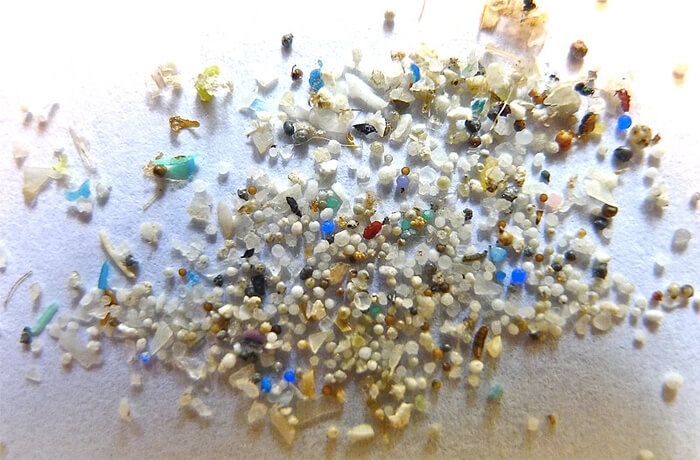The human species has made unquestionable leaps in technology, medicine, overall health and longevity. But we seem to always create more problems as we move forward. As an innovation, plastics have certainly served a purpose. But they have also led to environmental destruction and they are now a direct threat to our physical health.
Plastic products have only been around since the 1950’s. What is astonishing is that in this short time period, the amount of plastic waste produced is equivalent to more than 25,000 Empire State Buildings. It gets worse. The amount of plastic waste produced is growing at an exponential rate despite the fact that the environmental and health concerns are increasingly coming into focus. Plastic production is expected to at least double by the year 2050.
The proliferation of plastics, specifically microplastics, is now so severe that they can be found in almost any living organism, often times in the cells themselves. If you want the real headline to this article, it is Microplastics: things are much worse than we thought. And we are only just beginning to wrap our heads around the problem.
What are Microplastics?
Microplastics are any plastic that is less than 5 millimeters. As Sara Dudas explains in the video below, there are two types of microplastics. The first category is primary microplastics. These are microplastics that are specifically designed to be small. For example, microbeads that can be found in some cleaning products and skin cleansers.

The other category is secondary microplastics. These are the result of larger plastics that break down over time. There are many forces that contribute to the breakdown of larger plastics, but ocean currents and the sun’s radiation are two of the most significant. The number one culprit when it comes to secondary microplastics is single use plastics, which are plastics that are designed to be used once, such as a straw.
How Present are Microplastics in our Environment?
Microplastics have now made it to every nook and cranny of the globe. They are present in all of the oceans and even in the snow in Antarctica. They are in animals. They have been found in everything from chicken to salt and to beer. And they are now in us.
The smallest microplastics, called nanonplastics, are actually able to enter our cells and possibly cross the blood-brain barrier.
Are Microplastics Bad for Us?
The million dollar question. Despite their proliferation, the effects of microplastics on our health has not been extensively studied. The scientific community has only recently launched serious research on this issue. But scientists are understandably worried.
There is no reason to think that microplastics are anything but harmful in our bodies. We know from years of evidence that asbestos flakes get into the lungs and cause inflammation, which eventually leads to cancer. In other words, foreign bodies inside of us can cause problems just by being there.
Then there is the additional concern of the plastic content itself (Bisphenol A, commonly known as BPA, is a perfect example of this) and the chemical compounds they may have come in contact with before entering our bodies. There is already evidence that microplastics can disrupt our endocrine (hormonal) system.
And then we come to nanoplastics, where the science has only scratched the surface of possible harmful effects.
How Do You Remove Microplastics From Your Water?
Regular pitcher based, pour-through filters do not remove all, or even most, microplastics. A filter on your tap? Same deal. Your Brita or PUR filters do not remove microplastics. Sure, some of these filters will remove larger microplastics that are above a certain diameter. But they are certainly not removing nanoplastics, which in the end may do the most harm.
It is possible to filter out microplastics with microfiltration and nanofiltration, the latter being the more effective of the two. But if you really want a comprehensive solution for filtering out microplastics, a reverse osmosis system is the solution.
Microplastics have only been on our radar since 2018 if we’re being honest. There will likely be more home-based solutions to remove microplastics as time goes on. It is our hope that microplastics will be increasingly in the spotlight and the research will expand and widely inform the public. This will put more pressure on policy makers and companies, whether they are producing plastics or products to remove microplastics from the environment.
For now, look to a reverse osmosis system if you are looking for a whole-home solution. Another way to avoid microplastics is to find a local spring. Real spring water is uncontaminated and free of microplastics. We have written about how to find a spring here. This option may not be convenient for some, depending on your location and your means, but it is becoming easier to find and source so-called “raw water.”
What Can You do to Stop the Production of Microplastics
In the Sarah Dudas video above (watch it if you have not already), she outlines several things that we all can do to minimize the production of microplastics and their entry into the environment. Stop using single-use plastics. That is number one. Try to reduce your use of plastics overall. When it comes to storage containers, try to use glass. You can even find larger glass containers for storing spring water now.
Reuse and recycle whenever you can. Clothes with synthetic fabrics (most clothes these days) are enormous contributors of microplastics in our environment. Try to find clothes with natural fabrics or at least try to get the most out of your existing clothes that may have synthetic fabrics.
If you have any tips for avoiding microplastics or removing them from your water and your living environment in general, drop them in the comments below. There are lots of resources in this article but we are always keen to learn more.







{ 0 comments… add one }